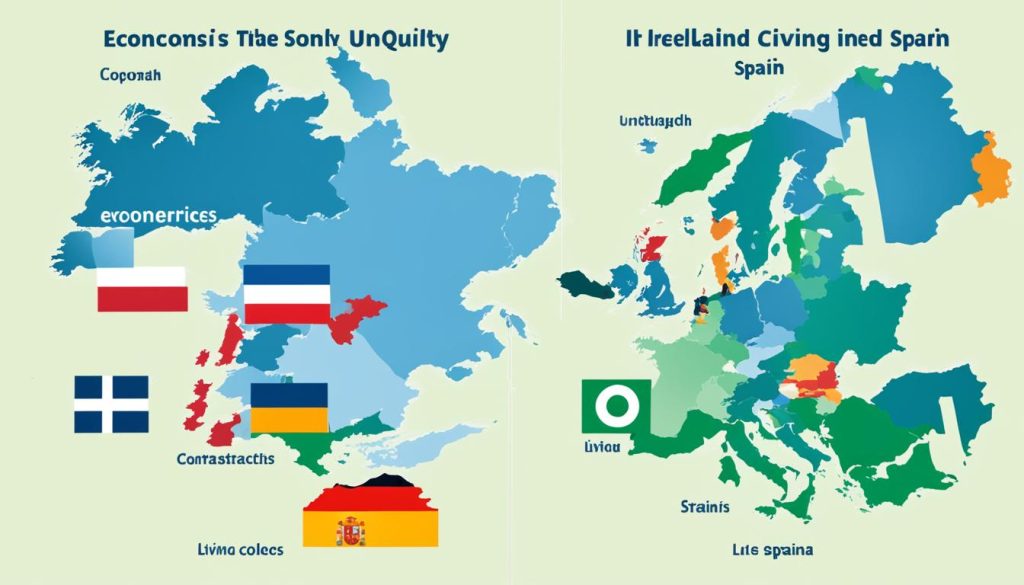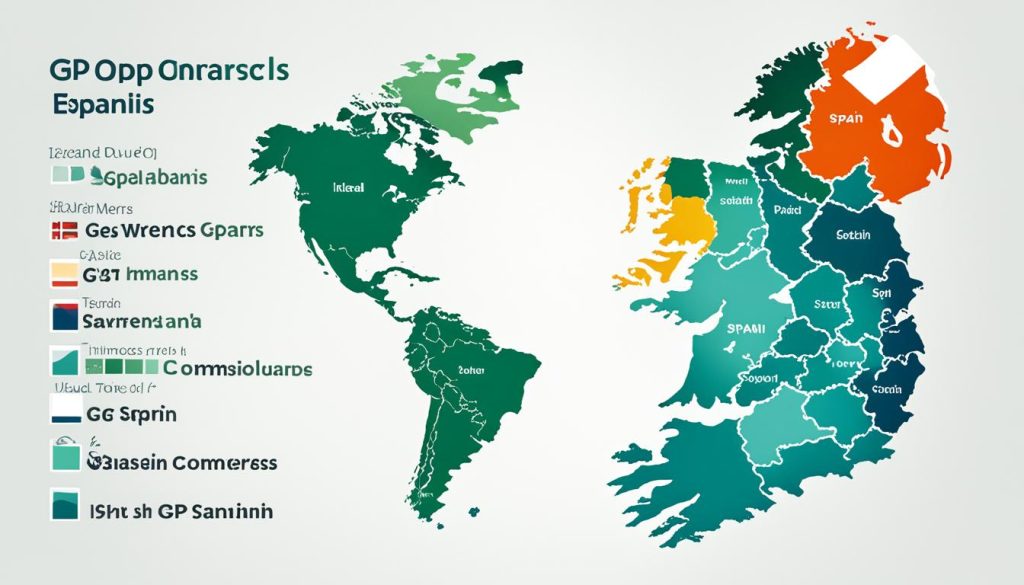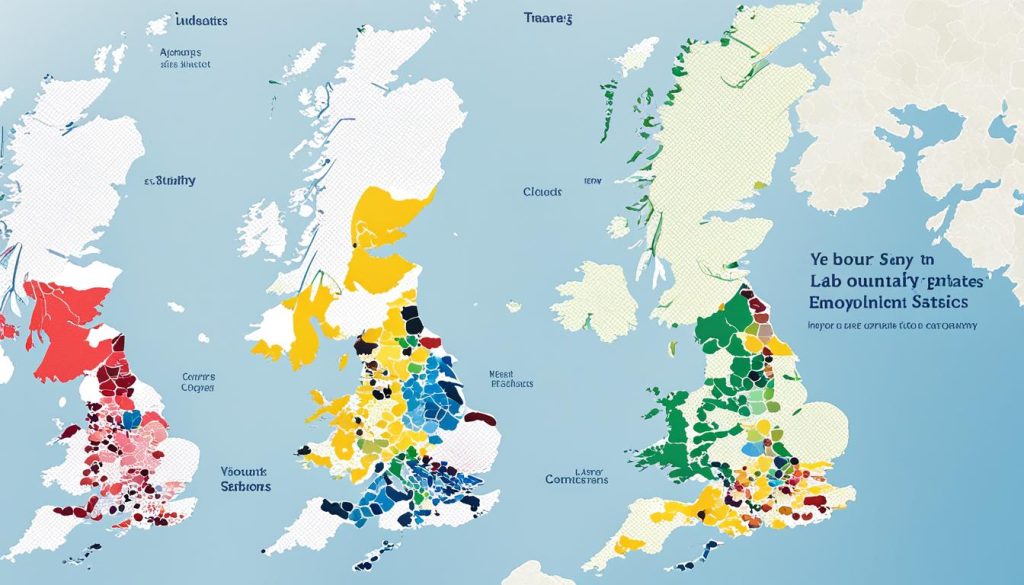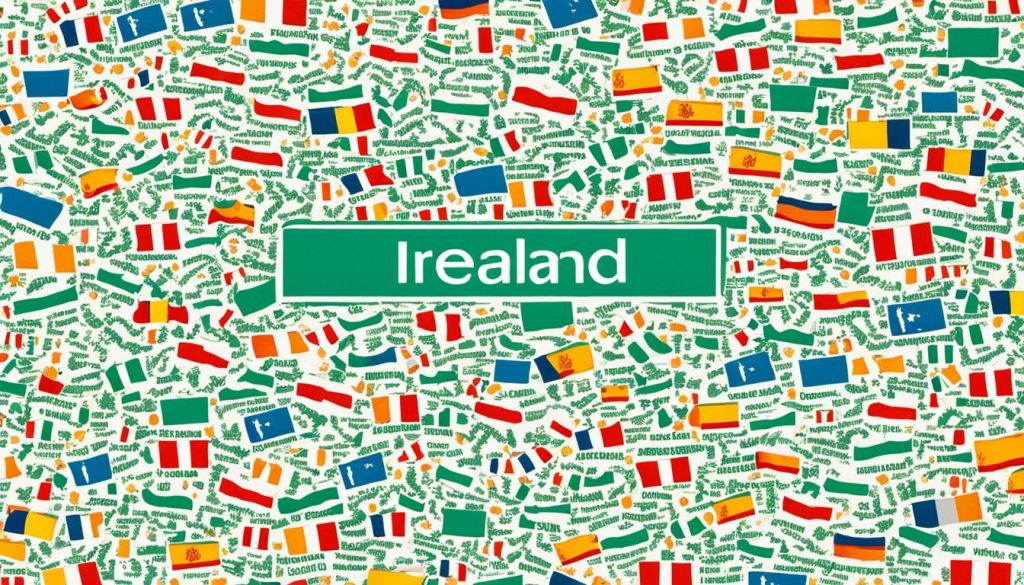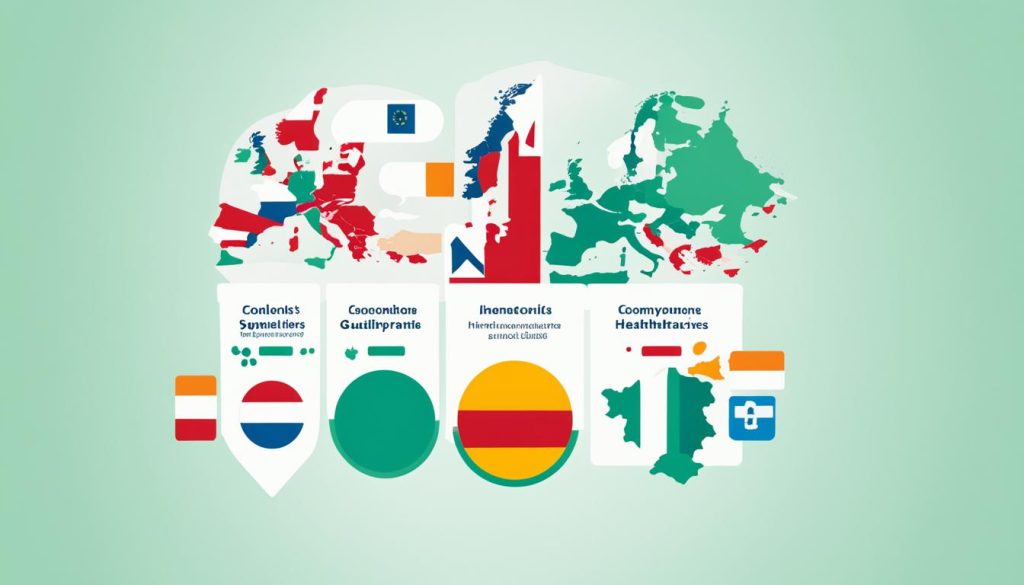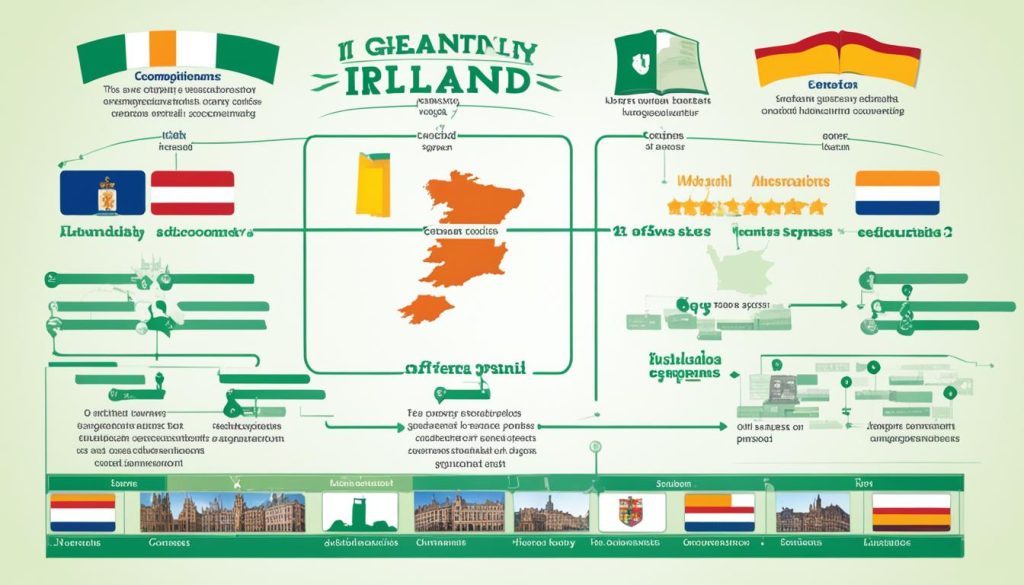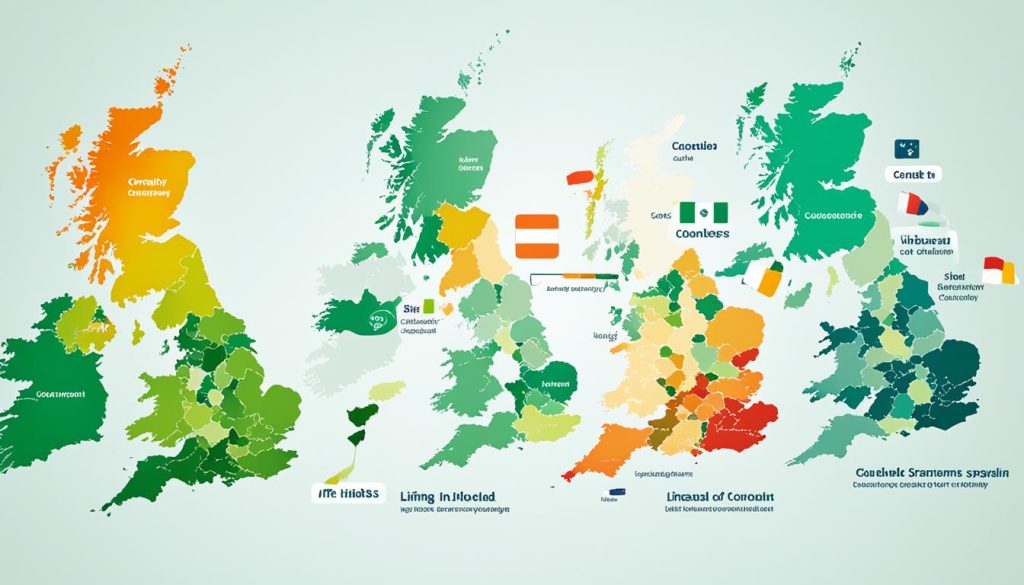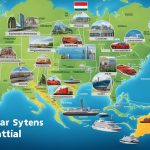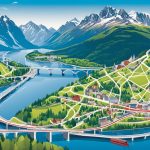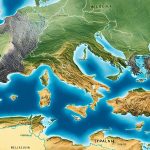Comparing economies and lifestyles in Ireland, the Netherlands, and Spain is vital for choosing where to live and work. These countries offer contrasting views of prosperity and well-being. Our analysis will highlight how each country’s economy supports the way people live there.
Ireland, the Netherlands, and Spain have different economic strengths and cultural vibes. Many wonder about the balance between a strong economy and a good life. We will look at various factors to see what life is like in Ireland, the Netherlands, and Spain.
Comparing GDP: Economic Strength of Ireland, Netherlands and Spain
Understanding how strong a country’s economy is helps us know its place in the world and its people’s prosperity. The Gross Domestic Product (GDP) is a key tool for this. It looks at the value of all goods and services made in a country. When we adjust GDP for purchasing power (PPP), we get a clear view of how wealthy people are in Ireland, the Netherlands, and Spain.
This helps us see which country ranks higher economically, not just in the European Union but worldwide.
Purchasing Power Parity and Per Capita Insights
Looking at GDP per capita, after adjusting for purchasing power, shows big differences between these countries. Ireland stands out with a GDP per capita of $99,239. This suggests its economy is strong, making its people richer than those in many other European countries.
The Netherlands is next with $60,461, while Spain has $41,546. These figures show Spain’s unique economic hurdles and potential.
Growth Trends and Economic Forecasts
Looking into the future, studying growth trends and forecasts helps us predict how these countries will do. Ireland’s growing rapidly, hinting it will climb higher in economic ranks.
The Netherlands and Spain, however, face different futures due to their distinct economic strategies and market conditions. This gives us a peek into how flexible and viable their economies could be long-term.
Sector-Specific Contributions to GDP
- Exploring key industries in Ireland, the Netherlands, and Spain shows the roots of their economic success. Ireland is a leader in technology and pharmaceuticals, which significantly boosts its economy.
- In contrast, the Netherlands excels in logistics and agribusiness, playing a big part in its GDP and global standing.
- Spain’s focus is on tourism and services, showing how its economy is closely tied to culture and leisure activities.
Understanding these industries gives us deeper insight into the economic character of each country. It helps in making informed economic decisions on both personal and institutional levels.
Labour Market Dynamics Across Ireland, Netherlands and Spain
Looking at the labour markets in Ireland, the Netherlands, and Spain tells us a lot about their economies. It shows us how well they’re doing at keeping their people working. We see the impact of things like unemployment rates and how easy it is to find a job.
Unemployment Rates and Job Market Fluidity
We start by looking at unemployment rates. This tells us how strong an economy is. It also shows if people can move between jobs easily. This is good for both workers and those hiring.
- Interpretation of current unemployment statistics
- Examination of workforce participation and mobility
- Identification of industries with high fluidity
Workforce Educational Levels and Skills
Education and skills are key in Europe. They help a country compete globally. The level of education in the workforce affects job quality and innovation.
- Insight into the correlation between education and employability
- Analysis of continuing education and upskilling initiatives
- Comparison of vocational and higher education outcomes
Impact of Digitalisation on Employment
Digitalisation is changing jobs and creating new ones. Countries using digital tools well can transform their labour markets. They make jobs that meet future needs.
- Review of digital skills within the workforce
- Quantifying the impact of automation on job prospects
- Exploring initiatives to boost digital literacy
In the end, these points show how ready the labour markets are for the future. They link economic growth with better living standards in Ireland, the Netherlands, and Spain.
Analysis of Cost of Living: Ireland Vs Netherlands Vs Spain
Understanding the cost of living is key for those thinking of moving to Ireland, the Netherlands, or Spain. The cost of living index, affordability, and daily living expenses differ widely across these countries. It matters not only how much you earn but also how much you spend on living.
We aim to clear things up by looking into the economic facts of living in each country. This involves comparing everyday spending on essentials like food and clothes.
This comparison will show the true cost of living. It gives insights into how pay measures up against expenses. Thus, it sheds light on how affordable life really is for people in these countries.
- Living Expenses: A direct comparison of how daily spending on food, clothing, and other essentials can differ greatly between Ireland, the Netherlands, and Spain.
- Affordability: This examines wages against living costs, giving a more nuanced view of how truly affordable life is for the common resident in each country.
- Cost of Living Index: The index is a helpful barometer, translating the expenses into a relative score, allowing for an easy, direct comparison.
Knowing about these costs is vital for anyone planning to move. We help future residents understand the financial aspects of their choice. This is so they can make a well-informed decision.
Compare Economy and Quality of Living Between Ireland, Netherlands and Spain
When looking at living standards in Ireland, the Netherlands, and Spain, you have to think about many aspects. These include the happiness and overall life satisfaction of the people there. Each country is unique, affecting its residents in different ways. Living standards involve more than just money. They include social and living conditions too.
Overall Standard of Living Across Nations
The Netherlands is known for its high standard of living. It scores well on many well-being indicators. These indicators include income, social security, environmental quality, and work-life balance. Ireland and Spain, however, offer different scenes. Their unique cultures, economies, and social services influence their residents’ lives.
Residency Advantages Unique to Each Country
- The Netherlands offers special benefits for residency. One example is the Dutch-American-Friendship-Treaty (DAFT). It helps American entrepreneurs start businesses in the Netherlands.
- Spain attracts people with its warm climate and rich culture. It offers a relaxed life with lively cities and beautiful sceneries.
- Ireland is known for its strong community and growing economy. It’s a place where tradition and innovation meet. This allows for a balance of work and cultural ties.
These European countries provide special qualities that enhance living experiences. They stand out for their life quality and general well-being. These are key points for anyone thinking about living in Europe.
Insights into Healthcare Systems in Ireland, Netherlands and Spain
Understanding the quality and availability of healthcare is vital. It shows us how people live in different countries. Let’s compare healthcare in Ireland, the Netherlands, and Spain. The Netherlands often leads in healthcare, but how do Ireland and Spain perform?
In healthcare quality, the Netherlands shines. It focuses on patient happiness, prevention, and treatment success. Its well-organised primary care system gives citizens quick and thorough medical services. Ireland blends public and private healthcare. However, the service quality varies depending on one’s insurance.
Spain offers universal health care. It gives good medical services to all, making its people live longer. But Spain struggles with long waiting times and how resources are shared.
- Primary Care Efficiency: It helps avoid unnecessary hospital visits.
- Patient Empowerment: Knowing about health is key to healthcare success.
- Medical Staffing: It affects both the access to and quality of healthcare.
Budget choices and policies in Ireland, the Netherlands, and Spain are important. They affect the quality of healthcare. Each country’s system affects how patients feel and their health outcomes.
- Public Funding: How much is spent on public healthcare.
- Private Sector Role: How it helps increase healthcare access and new solutions.
- Affordability: The costs shared by government, insurance, and individuals.
Despite differences, Ireland, the Netherlands, and Spain aim to offer good healthcare. This shows the complex nature of healthcare systems, influenced by culture, economy, and policies.
Evaluating Education Systems: A Comparative Study
In the race for global recognition, Ireland, the Netherlands, and Spain’s educational standards play a huge role. These standards are key in their global rankings. By looking at their educational systems, we see their teaching methods and the values they hold dear.
Global rankings test educational systems on factors like student success, research, and the school’s reputation. These rankings show how Ireland, the Netherlands, and Spain are committed to growing knowledge and innovation.
Quality of Education and International Rankings
The quality of education is often seen through international rankings. These rankings show how dedicated a country is to preparing students for the future. Ireland, the Netherlands, and Spain’s high-quality education makes their graduates very attractive to employers worldwide. This strengthens the link between good education and economic growth.
Access to Higher Education and Vocational Training
Access to good education, including higher education and vocational training, is vital. It helps individuals grow and builds a strong workforce. By looking at the opportunities in Ireland, the Netherlands, and Spain, we see how inclusive their systems are. This inclusivity helps society progress.
- Assessment of university education and its alignment with contemporary global challenges
- Exploration of vocational training programs and their relevance to evolving industry needs
- Impact of educational outreach on creating equitable chances for all demographics
Chasing academic excellence remains a top goal for these European nations. Their future economic success and societal health rely on it. Each country is continuously working to lift their educational standards. They aim to expand access and improve quality for everyone.
Infrastructural Advancements: A Closer Look
The link between a country’s infrastructure quality and its success is crucial. Ireland, the Netherlands, and Spain show how infrastructure boosts the economy and daily life. Their focus on technology and transport shows the blend of innovation and sustainability. By looking closely, we see how they connect dreams with reality.
Transportation, Communication and Technology Infrastructure
Good transport systems are key to a country’s economy. Looking at Ireland, the Netherlands, and Spain, we see a range of efforts. From trains to cutting-edge tech, their aim is clear: to connect and advance.
- Rail and road networks that underscore the robustness of a modern commute
- Communication frameworks that empower both individuals and enterprises
- Technology incubators that set the stage for tomorrow’s innovations
In terms of infrastructure, the Netherlands leads with its integrated transport. Its systems are a model of efficiency and focus on users.
Investments in Smart Cities and Sustainable Practices
Investing in smart cities and sustainability is a key strategy. Ireland, the Netherlands, and Spain are investing in the future, designing urban areas for tomorrow.
- Initiatives that embody a forward-looking perspective on energy conservation
- Projects that exemplify smart city paradigms, weaving technology with urban living
- Investments that are not merely monetary but a token of a dedication to sustainability
These efforts prove their commitment to a greener world and better living. They aim for progress that is both big in impact and sustainable.
Examining Taxation: Implications for Individuals and Businesses
Taxation plays a big role when looking at a country’s economic appeal. Different tax rules, covering income and business taxes, can influence where people choose to live and work. This piece compares the tax systems in Ireland, the Netherlands, and Spain. We will look at their individual and business taxes, benefits, and incentives. We’ll also see how these affect business opportunities and personal finances.
Understanding Personal Income and Corporate Tax Structures
Personal income tax varies a lot between Ireland, the Netherlands, and Spain. Each country has its own rules that affect what people take home as pay. Business taxes also differ and impact where companies decide to set up or grow. For example, Ireland’s business tax is really low compared to other EU countries. Meanwhile, the Netherlands has the ‘Innovation Box’. It offers lower tax rates for earnings from new inventions.
Comparative Analysis of Tax Benefits and Incentives
- An assessment of the financial benefits derived from tax incentives that promote economic development and innovation.
- Evaluation of how tax policies in each country are tailored to facilitate business growth, particularly for small and medium-sized enterprises.
- An exploration of tax rebates and special schemes designed to attract foreign investment into varied economic sectors.
In Spain, there are various tax credits for investing in research and development. Looking at these tax benefits shows how countries focus on certain industries or activities. It’s important for companies planning to grow internationally to understand these incentives well.
Quality of Life Indicators: A Comparative Perspective
When looking at life satisfaction and well-being measures across countries like Ireland, the Netherlands, and Spain, we see unique results. Each country shows how its society affects quality of life. The OECD’s Better Life Index and the Human Development Index help us understand these differences. They look at economy, education, environment, and health to show how societies are doing.
- Exploring life satisfaction helps us see how people feel about their lives. It tells us if they find life worthwhile.
- Well-being measures cover everything important for a healthy life. This includes how we feel, our work-life balance, and our relationships.
- A quality of life comparison shows if people can thrive. It checks if they meet both basic and higher goals.
This analysis highlights the complexity of living well in different countries. But numbers don’t show everything. People’s experiences and cultural values also matter a lot.
Looking into these indicators helps everyone. Policymakers, businesses, and individuals can all find useful insights. It shows where things are good and where we need to improve for better life satisfaction and well-being.
Retail and E-Commerce Markets in Ireland, Netherlands and Spain
The retail industry is changing fast in Europe. Ireland, the Netherlands, and Spain are leading this shift. They show unique ways of combining traditional shops with online sales. This gives us a sneak peek into the future of shopping.
In Ireland, mixing old-fashioned retail with new e-commerce methods is key. Local businesses are getting a big boost from this. They’re reaching more customers online now.
The Netherlands has a top-notch e-commerce scene. It’s one of Europe’s most tech-forward countries. People there really enjoy shopping online. Their strong delivery systems and digital setup make it easy.
In Spain, e-commerce is playing catch-up with the Netherlands. But it’s growing quickly. More and more, Spanish shoppers are enjoying the ease of buying online. This growth is helped by better mobile internet and local online stores.
- Consumer Preferences
- Irish support for local shops transitioning online.
- Dutch proclivity for fully digital shopping experiences.
- Spanish growing demand for mobile e-commerce solutions.
- Digital Adoption
- Rapid growth in online retail infrastructure in Spain.
- Robust digital connectivity underpinning the Dutch e-commerce market.
- Ireland’s investment in new technologies to integrate online and offline retail.
- Market Maturity
- Netherlands leading with a highly mature e-commerce landscape.
- Spain’s emerging market showing significant growth potential.
- Ireland’s balanced focus on both traditional and online retail outlets.
This isn’t just theory. It’s crucial for businesses looking to grow in these markets. It’s also important for shoppers wanting the best deals. Retail industry changes, driven by digital platforms, will guide future buying habits.
The Impact of Digital Economy on Living Standards
The rise of the digital economy has changed how we live worldwide, especially in tech-savvy countries. In Ireland, the Netherlands, and Spain, technology shapes living standards differently. These countries all focus on improving their tech, but the outcomes vary for their people and economy.
In the Netherlands, incorporating online services into everyday life boosts living standards. Ireland is becoming a tech centre, using technology usage to drive economic growth. In Spain, growing digital markets change how people shop and access services.
- Digital literacy and its link to job market readiness.
- Boosting public services with e-governance.
- Using online services to broaden educational and job opportunities.
- How high-speed internet helps with working from home and job flexibility.
- Looking at how broadband helps include remote areas economically.
- Studying the digital setups that push healthcare and wellness innovations.
- Evaluating the impact of tech startups on the economy and wealth.
The deep role of the digital economy in these countries shows its importance in society’s progress. Despite their differences, they share a crucial point: embracing tech improves living standards by opening new ways for business, learning, and personal development.
Assessing Property Markets and Housing Affordability
Looking at the property market in Ireland, the Netherlands, and Spain shows different investment chances and housing costs. It’s key to look closely at how people can afford homes. This includes whether they choose to rent or buy in these varied markets.
Real Estate Prices and Investment Opportunities
The strength of the property market shows a country’s economic health. Ireland is growing fast, leading to high property prices. This makes investing there different from Spain, where the market is improving. Spain offers good value to investors. The Netherlands stands in the middle, attracting both local and international investors. Yet, living in cities like Amsterdam can be costly.
Renting Vs Buying: A Comparative Analysis
When looking at renting affordability, we need to consider living costs and the balance of supply and demand in rentals. Ireland has a very tight rental market, making it hard for many to afford. Spain, however, has a variety of rental options. The Dutch market features strong social housing but expats may find it hard to access due to long waitlists.
Discussing home ownership, it’s clear that buying a house is a big financial step in these countries. It depends a lot on the economy and mortgage rates. As the 14th part of our series shows, knowing these markets well can help those wanting to invest or buy a home in Europe.
Exploring Cultural Influences on Economy and Living Quality
Society is shaped by culture, values, and the way we live. These factors mix to mould the economy and life in Ireland, the Netherlands, and Spain. By looking at these aspects, we see how culture and norms support living standards and economic health.
In Ireland, tradition and community play a big role in the economy. Family and social connections help local businesses and small enterprises thrive. This strong community support boosts the economy and improves life quality, making local initiatives successful.
The Netherlands, however, values innovation and tolerance. Its culture leads to a lot of entrepreneurship and a business scene that’s both competitive and cooperative. Also, the Dutch focus on keeping a good balance between work and life. This ensures people don’t sacrifice their happiness for economic gain.
- Values that push for sustainable and innovative business methods.
- The global recognition of Dutch design and engineering as cultural achievements.
- Policies that improve life by focusing on family time, fun, and self-growth.
Spain’s lively culture and focus on social well-being shape its economy to put life quality first. Its love for community and leisure influences consumer habits, benefiting sectors like tourism and food. The Spanish view work as more than just a job; it’s also about passion and creativity. This outlook motivates people to work with purpose, enhancing their quality of life.
- The influence of family and community on market trends and business ethics.
- The mix of arts, heritage, and innovation in economic projects.
- Cultural values reflected in policies that improve healthcare, education, and housing.
Looking at the cultural diversity of these European countries, we see a range of economic and social well-being. How cultural nuances mix with economic structures shows us various ways to improve life quality. Ireland’s community spirit, the innovative Dutch, and Spain’s lively society each teach us about growing economically while enriching lives.
Conclusion
We’ve looked closely at Ireland, the Netherlands, and Spain, comparing them through economic eyes. This helps individuals and businesses decide where they might live, invest, or visit. Each country has its mix of pros and cons. These are based on their economy, society, and life quality. We also looked at living standards, healthcare, education, and infrastructure. This gives a solid base for making choices.
Ireland shines with strong economic numbers. The Netherlands stands out for its healthcare, tech-savviness, and education. Spain brings its vibrant culture and low cost of living into the picture. It shows great opportunities for business and living. We’ve gathered important data and insights. This is key for anyone looking at these countries for their next move.
Wrapping up, this analysis of three dynamic economies is a guide for global movers and business folk. It balances economic review with social and cultural factors. We hope it helps people find their best fit. In today’s world, knowing a country’s economic setup is crucial for success.

